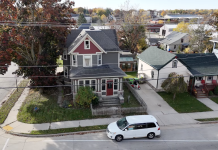September 21, 2019 – West Bend, WI – Since the 75th reunion of the Class of 1944 was such a hit we’ll spin the clock back to 2015 and a reunion that occurred from the Class of 1935. It had been 80 years since Lillian Moritz Oelhafen and Frieda Kaehny Hauser graduated high school. Their story is below. 
There was an 80 year West Bend High School class reunion Friday. It was a rather intimate affair as the two remaining students, Lillian Moritz Oelhafen and Frieda Kaehny Hauser, from the class of 1935 got together for breakfast.
“We’re both 98 and we both walked down the aisle together at graduation,” said Lillian Oelhafen.
The ladies arrived with daughters in tow. Judy Etta chauffeured her mother Lillian. “Both Frieda and my mother also worked at the Ziegler Company and Frieda held a hanky bridal shower for my mother,” Etta said. “Everybody brought hankies to the shower for the bride instead of other gifts and my mother used that hanky for her wedding and she still has it today.”
In 1935 the President of the United States was Franklin D. Roosevelt. The principal at the West Bend High School was D. E. McLane. The top hit on the billboard charts was Fred Astaire and ‘Cheek to Cheek.’ The Homecoming king at West Bend High School was Roger O’Meara and the makeup of businesses across from the school on Main Street included Amity Leather Company and the Schmidt family farm.
The entire class of 1935 fit in the corner at Perkins Restaurant. Two silver helium balloons that read ‘Congratulations’ floated above the table. Frieda and Lillian wore special red-and-white corsages (the school colors) designed by Bits n’ Pieces floral. The flowers were finished off with a red ribbon that had ‘Class of 1935’ stamped in gold print.
The reminiscing drifted back to an era that included things like earning certificates for shorthand, courses of typing and bookkeeping, and commercial teacher and guidance Chairman Miss Gertrude Forrester. “She was an old maid,” said Lillian. “She had long hair and a coil and she always had a handkerchief up in that coil.”
The Class of 35 laughed and teased a lot. “Both of us were on the Honor Roll but Lillian was a smarty,” said Frieda downplaying her own class status. Lillian graduated third in her class and Frieda, according to Lillian’s recollection, was 10th.
Both were hired after school to work at the B.C. Ziegler Company. “I got 25 cents an hour and had to run from school to the office downtown because I wanted to get another hour in,” said Lillian. The Ziegler Company, at the time, was located by First National Bank. “I worked for D.J. Kenny, Walter Kratz and Arnold Miller and they were the guys that worked on the prospectus,” she said.
Frieda was a bookkeeper and worked for a ‘tough guy’ named Leonard Thorson. “At least we had a job,” she said. “It was very hard for a woman to get a job in those days and we had to have a certain grade point or they wouldn’t have hired us.”
Both women were extremely sharp and grateful recalling how fortunate they were to even go to high school. Lillian, whose parents were in Kohlsville, lived with her grandparents on Highway 33, also known as Cedar Street. Frieda lived several miles out of town at Gumm’s Corner, in the home where she resides today.
“I was involved in everything, all the sports,” said Frieda. “I don’t recall having uniforms; we had them for gym but we wore our regular shoes.”
According to the class yearbook Frieda Kaehny was involved in basketball, baseball, track, volleyball, Bend staff, prom committee, home economics club and Dust Pan Staff.
Lillian was involved in the Dust Pan too. “It was our school newspaper,” she said. “Actually, it was a newsletter that came out once a month.” The rest of Lillian’s high school participation included things like operetta, glee club, guidance chairman, prom committee and honor roll.
A waitress from Perkins stopped by the table to inquire about the celebration. “Is it a birthday,” she asked. “This is our 80th class reunion,” said Lillian. “Ooh awesome. I love it,” said the waitress. “You’re awesome. That is too cool; I just had to be nosy and come check it out.”
Frieda and Lillian were then encouraged to launch into their school song (sung to the tune of On Wisconsin).
The 80 year reunion was organized by Etta. “You know how you always say, ‘Oh yes, we have to do something’ but then it doesn’t happen in our busy lives,” she said. “But this is an occasion and we can’t let it go by without having them together… and they’re both alive. We’re very blessed.”
Update: Lillian Oelhafen died March 3, 2017.
Outtakes from the 80th class reunion: There were quite a few portions of conversation left out of Saturday’s article about the two remaining students from the West Bend High School class of 1935, Lillian Moritz Oelhafen and Frieda Kaehny Hauser.
The following are some random segments as the two ladies, both 98 years old, reminisced about their days growing up and working in West Bend.
School days
The principal at West Bend High School in 1935 was D.E. McLane. There were 86 students in the graduating class of 1935.
The topic of school lunch was rather popular and sparked quite a few memories. “Whatever our mothers packed we had for lunch,” said Frieda.
“I had only cold sandwiches in high school,” said Lillian. “In the winter when we’d walk to school and it would be very cold we’d get to school and our lunch was half frozen. We’d put it near the big belly stove and by the time we got to eat it had thawed.”
Lillian also recalled a prankster who rummaged through her lunch. “There was a boy in school who would steal the meat out of my sandwich,” Lillian said. “He’s long gone now but I still don’t like him.”
“I also had taken fresh strawberries in a jar in my lunch and that stinker went and put salt on my strawberries and when I went to get them – they were done and was I upset,” she steamed.
The Depression
“We would exchange coupons during the Depression,” said Lillian. “We raised our own meat so we had meat coupons and people we knew in Milwaukee had coffee coupons. They would give us the coffee and we would give them the meat.”
Lillian got married in 1939 to Harry Oelhafen. “He was a teacher in grade school,” said Lillian. “He was my teacher in eighth grade. There was a 10 year age difference.”
“We always thought you were too young for him,” teased Frieda.
Frieda got married in 1942 to Harold Hauser, who was a salesman for Mrs. Karl’s Bakery.
Telephone and polio
“We had a telephone in Kohlsville,” said Lillian. “But a lot of the neighbors did not so they would come to our house to do all their doctor calls. Our next door neighbor, their son died of polio but they would come to use the telephone my door was always open but when they left I was disinfecting. I was so worried I’d get it.”
One young man who survived polio ended up going to work at Disney World. “Each year he would come home to visit his brother and he’d stop to see me because he remembers that support,” said Lillian. “It’s nice he remembers what I really did.”
Generation of change and technology
Frieda’s daughter Trudy talked about how the generation of her mom and Lillian had lived through some of the greatest change in the century. “I’ve got an iPad,” said Lillian. “I’m writing a cookbook.”
Lillian is also writing her memoirs which include the story about the ice house and the mill.
Lillian grew up in Kohlsville across from what is now Jug’s Hitching Post. “My great grandparents, Ferdinand and Wilhelmina Sell, emigrated from Germany and came to America on their honeymoon in the 1800s,” said Lillian.
The couple set up their homestead in the Kohlsville area because it reminded them of their home in Germany. Ferdinand bought the local saw mill in 1893. There was also a grist mill by the lower pond and during winter they’d harvest ice.
“The ice could not have snow in it, it had to be clear ice,” she said. “They would have a big cross-cut saw, it took two men to handle it and they would saw blocks of ice 12 -15 inches square.”
Lillian remembered the ice was stored in a shed, where the Hitching Post parking lot is now. “They had a lot of saw dust from the mill and the ice was preserved in the sawdust,” she said. “They would have a layer of ice and a layer of saw dust and it was amazing how that ice stayed preserved.”
Otto Moritz married the Sell’s daughter and helped run the mill, which eventually became known as the Sell and Moritz Mill.
Lillian said her great grandparents lived in a home that had 16 rooms because “if they employed men they had to give them lodging.” She said the home still exists today, across the road from the Hitching Post.
“After the men cut the ice, they’d load the blocks on a big bobsled,” said Lillian. “Big strong draft horses would pull the sled to the ice shed.”
Lillian said the process was a dangerous business. “Farmers Frank and Ernest Rusch, they were bachelors, they had a good strong team of draft horses,” she said. “They came with their bobsled and load it up to haul ice to the shed and one day they broke through the ice and the horses drowned. It was just horrible.”
Boldt Drug Store
“We were working at the Ziegler Company and every afternoon we’d have somebody go over to R.W. Boldt Drug Store,” said Lillian. “We’d order a phosphate or soda and one person would go and they’d take the order and get it filled and bring it back to the office for a snack. I usually got a phosphate or raspberry sundae.”









I love your story. My mom,Dolores Morawetz, graduated from West Bend High in 1932. My father,Reuben Koch, in 1933. I graduated in 1961. So many of the places and people in the article are familiar to me.
I lived on Hwy 33 and it was called Cherry St. not Cedar St.. Cedar was one block south.
Thanks for the memories
Mary Gonske